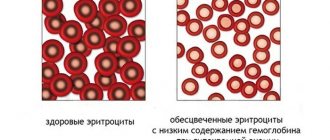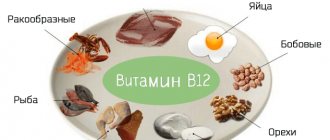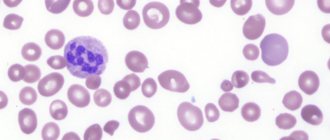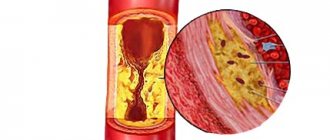Iron deficiency anemia (IDA) is one of the most commonly diagnosed pathological conditions of the circulatory system, and indeed the most common type of anemia.
Statistical studies have shown that about 2.5 billion patients worldwide have this diagnosis.
In order to stop the progression of the disease and avoid complications, it is necessary to identify the root causes of its occurrence and begin treatment in a timely manner.
What is iron deficiency anemia?
Anemia is characterized by a reduced content of red blood cells - erythrocytes - in the human circulatory system, and, as a result, a drop in hemoglobin.
If the low level of these elements is associated with a lack of iron in the body, then in this case we are talking about iron deficiency anemia (IDA).
As a rule, pathology is not an independent disease. In most cases, iron deficiency anemia occurs following some other negative changes in the human body.
FOR REFERENCE! The average iron content in the body in adults is about 4 grams. For men and women at different ages, this indicator may have different meanings. For example, iron deficiency anemia in adults is much more common in women. First of all, this is due to regular blood loss that occurs during menstruation. And the strongest concentration of iron is observed in newborn babies, since they have an increased supply of this trace element in the womb.
Iron deficiency has a negative impact on human vitality in general. In addition, the development of this deficiency is fraught with disruptions in the formation of red blood cells, as well as disruption of oxidation and reduction reactions, the mechanism of cell division and the normal course of some other reactions.
Iron is the basis of hemoglobin, which performs the function of supplying oxygen to all tissues and organs in the human body, and also plays an important role in the synthesis of protein and hormones. If iron deficiency is not replenished for a long time, the patient begins to develop anemic syndrome.
What are the reasons for the appearance?
Since iron deficiency in a woman’s body occurs as a result of a lack of hemoglobin in the blood, the causes of anemia are directly related to the deviation in the quantitative indicator of red blood cells and hemoglobin protein.
Chronic gastritis
Causes of female anemia:
Following diets low in iron , poor nutrition.
Genetic predisposition. Some types of anemia are hereditary (sickle cell).
Chronic gastritis. When affected by this disease, a significant decrease in hydrochloric acid occurs.
Intestinal bleeding . One of the most difficult to determine and unpleasant factors.
They do not indicate pain in the intestines, but only manifest themselves in a change in the shade of the stool. In most cases, this is not paid attention to.
Deviations in the formation of the hemoglobin protein , which leads to a significant decrease in the number of red blood cells.
The presence in the body of flatworms (helmitons), affecting various organs.
Excessive blood loss due to injuries and open wounds.
Gastric tract disorders , as a result of which iron absorption processes are disrupted.
Carrying a child . During pregnancy, the body consumes more iron, since the fetus itself feeds on it. That is why women who are pregnant need to monitor their hemoglobin.
Anemia is also possible for some time after childbirth.
Long-term illnesses . Kidney failure, stomach and intestinal ulcers, and liver pathologies lead to constant blood loss by the woman’s body.
Donation . Regular blood donation can also cause anemia. At this time, it is necessary to eat intensively to replace the blood lost by the body.
Low intake of vitamins B12 and folic acid . With vegetarianism and refusal of animal foods, improper diets, there is a deficiency of such important vitamins for the body.
Fact! The main factors causing iron deficiency in the body are pathologies of the gastric tract and poor diet. Up to 60% of female representatives suffer from anemia with constant dieting.
Causes of iron deficiency anemia
The reasons for the development of iron deficiency anemia may be a lack of iron entering the body from the outside, or failures in the processes that consume it, because the human body cannot produce this microelement on its own. They could be:
- unbalanced diet: poorly chosen diet, refusal to eat meat (vegetarianism);
- regular significant blood loss . In addition to menstruation in women, chronic blood loss can be associated with the presence of various diseases: stomach ulcers, hemorrhoids, decaying tumors and others. This also includes blood donation, which occurs more often than 3-4 times in one year;
- congenital factors that arose during intrauterine development: the presence of iron deficiency anemia in the mother, multiple pregnancy, prematurity;
- malfunctions of the gastrointestinal tract, as a result of which the process of iron absorption in the duodenum is disrupted. This may be due to the presence of various intestinal diseases (enteritis, gastritis, celiac disease, stomach cancer, Crohn's disease, etc.);
- liver diseases leading to disturbances in the production of transferrin, a protein that performs transport functions: microelements supplied with food are not distributed throughout the body, which causes iron deficiency. Transferrin synthesis occurs in liver cells;
- taking medications that affect the absorption and processing of iron in excess doses. These may include: non-steroidal anti-inflammatory drugs, antacids, iron-binding drugs. People with a predisposition to iron deficiency anemia should consult a doctor before using these types of medications.
Iron deficiency anemia in children can develop as a result of various pathologies during pregnancy, early transition to artificial feeding, accelerated growth rate (in case of prematurity).
Provoking factors of IDA
The body's increased need for iron is the main provoking factor for the development of iron deficiency anemia. It can be associated with such life processes as:
- pregnancy. During pregnancy, a woman needs almost twice as much iron for normal fetal development as in normal life;
- breast-feeding. As during pregnancy, while feeding a child, the female body uses much more iron than it can receive.
Features of treatment
Treatment of anemia in women is carried out after excluding other pathologies (leukemia, congenital anomalies, hemophilia). Complex therapy includes:
- Eliminating the cause of anemia. Treatment of existing inflammatory diseases, cessation of smoking and alcoholic beverages, avoidance of contact with chemicals, and treatment of helminth infections may be necessary.
- Taking medications. Iron deficiency anemia should be treated with iron supplements and complex products with vitamins and microelements. Ferro-Folgamma, Sorbifer Durules, Ferrum Lek, Ferlatum, Aktiferrin and Maltofer are used. For B12 and folate deficiency anemia, Folic acid and Cyanocobalamin are prescribed. Drugs such as Mamifol and Folacin are often used. For aplastic anemia, Epostim and Erythrostim are effective. For anemia of autoimmune etiology, corticosteroids and immunosuppressants are used.
- Strict diet. Sick women need to avoid foods that impede the absorption and absorption of iron (black tea, soy, rice, milk). You need to eat foods rich in folic acid, iron, vitamin C and cobalamins more often. Red meat, liver, vegetables, fruits, yeast, eggs and greens are beneficial. It is necessary to diversify your diet as much as possible. This will ensure that the body receives the necessary substances.
- Maintaining a healthy lifestyle.
- Red blood cell transfusion. Required for severe blood loss and low hemoglobin levels.
- Administration of infusion agents (hypertonic solutions, electrolytes, glucose solution with ascorbic acid). Effective for acute posthemorrhagic anemia in women.
- Correction of the heart, kidneys and liver. For this purpose, symptomatic drugs are prescribed.
- Removal of the spleen (splenectomy). This operation is most effective for hemolytic anemia with microspherocytosis.
- Forced diuresis. Required for anemia of toxic nature.
Important information: How to treat Minkowski-Choffard anemia (hereditary spherocytosis) in children
Stages of development of IDA
The pathogenesis of this type of anemia is expressed in two main periods:
- The latent (hidden) period is characterized by a decrease in iron reserves in the body, as a result of which ferritin levels drop. However, other laboratory parameters in the blood test may remain within normal limits. The body tries to compensate for the lack of a microelement by more active absorption in the intestines and the production of transport protein. Due to this, IDA has not yet occurred at this stage, although the prerequisites for it are already present.
- Direct iron deficiency anemia occurs when the level of red blood cells decreases so much that they can no longer sufficiently provide their functions. At this stage, the main symptoms and characteristic features of the disease begin to appear more clearly.
Stages and degrees
Iron deficiency anemia in women (symptoms make it possible to identify disorders at an early stage of the disease) gradually passes through several stages as pathological processes progress:
| Name | Description |
| Stage 1 (prelatent) | Iron consumption is greater compared to its intake into the human body, but its reserves are sufficient for the normal functioning of many systems. To restore iron levels, it is enough to correctly adjust your diet and add dietary supplements to your diet. |
| Stage 2 (latent) | Iron stores gradually decrease, but hemoglobin levels are normal. Specific signs of disturbances appear. The study will show a decrease in ferritin and transferrin. Latent iron deficiency anemia in women requires proper nutrition and the use of dietary supplements (BAS). In some situations, patients are prescribed medications with iron. |
| Stage 3 | Pathological processes gradually progress, but the level of red blood cells remains normal. |
| Stage 4 | Microcytic hypochromic anemia develops. |
| Stage 5 | Lack of iron leads to disruption of metabolic processes in tissues. The first serious symptoms of iron deficiency anemia appear. |
It is important to establish the main cause of iron deficiency in the human body. In most cases, this is bleeding. Anemia can also be the result of a serious illness. It is necessary to diagnose pathological processes and begin treatment under the supervision of a specialist.
Considering the amount of hemoglobin in the blood, the following degrees of development of iron deficiency anemia are distinguished:
| Name | Description |
| No anemia | Hemoglobin level is above 120 g/l. |
| I degree | Indicators decrease to 90-120 g/l. Consultation with a hematologist and corrective therapy is required. |
| II degree | Hemoglobin levels range from 60-90 g/l. The woman requires urgent therapy. |
| III degree | Hemoglobin is below 60 g/l. The patient is indicated for hospitalization and intensive treatment. |
A blood test will help determine the stage and degree of development of the pathological condition. In some situations, the doctor prescribes additional laboratory tests.
Types of iron deficiency anemia
Classification of the disease according to its causes distinguishes the following types:
- anemia resulting from excessive blood loss;
- iron deficiency anemia, which appeared as a result of malfunctions of red blood cells;
- chronic iron deficiency anemia;
- hemolytic anemia (increases with a high degree of destruction of red blood cells).
Classification according to hemoglobin level divides the disease into types depending on severity:
- mild severity (hemoglobin content more than 90 g/l);
- moderate severity (70-90 g/l);
- high severity (below 70 g/l).
What are the consequences of anemia and what is its danger?
To prevent the progression of anemia with the development of complications, you should consult a qualified doctor who will prescribe effective therapy.
Low hemoglobin levels are dangerous for a woman’s body because they lead to hypoxia (lack of oxygen in tissues and organs, including vital ones).
Ignoring the signs of anemia can lead to the following consequences:
- Deviations of organ function. A small amount of oxygen significantly affects the functioning of internal organs and tissues. With its deficiency, various types of deviations occur, including serious ones,
- Nervous system disorders. Possible disturbances in sleep patterns, decreased intellectual abilities, emotional instability, short temper, aggressiveness,
- Malfunctions of the cardiac system. The heart begins to work with greater force, with a lack of red cells in the body, in order to compensate for them. As a result, it wears out quickly and cardiac arrest due to anemia is a frequently recorded factor,
- Decline of the immune system. Weak immunity leads to rapid incidence of infections. The chance of progression of diseases associated with low immunity increases.
Symptoms of iron deficiency anemia
The degree of IDA increases gradually in the body and at first may hardly make itself felt. The latent period of the disease is characterized by the manifestation of sideropenic syndrome.
Later, a general anemic syndrome begins to appear, the clarity of which is determined by the severity of anemia and the body’s ability to resist. The presence of the following signs in a patient may indicate iron deficiency anemia:
- fatigue and chronic muscle fatigue . With iron deficiency in the body, a person's muscles become weaker. Their daily work requires a lot of energy, which is no longer produced in the required quantity due to a decrease in the level of red blood cells. As a result, a person gets tired much faster even with small everyday loads. Iron deficiency anemia in children can manifest itself in the child's desire for less active play, lethargic behavior and drowsiness;
- the appearance of shortness of breath. With IDA, it is difficult to supply the heart with oxygen due to deterioration of blood circulation. For this reason, the patient may experience increased heart rate, shortness of breath and lack of air;
- deterioration of the condition of the skin, nails and hair. Iron deficiency becomes noticeable externally (see photo above), when the skin becomes dry and cracked, and pallor appears. Nails weaken, break and become covered with specific transverse cracks. In some cases, the nail plate may bend in the opposite direction. The hairline is thinning. Hair changes its structure, gray hair appears prematurely;
- damage to mucous membranes . One of the early symptoms of IDA is damage to the mucous membranes, because these tissues most acutely feel the lack of iron due to disruption of various cellular processes: damage to the mucous membranes is most clearly noticeable in changes in the appearance of the tongue. It becomes smooth, covered with cracks and areas of redness. Pain and burning sensations are added. In some cases, sharp disturbances in taste perception are observed;
- dryness and areas of atrophy appear in the oral cavity. There is discomfort when eating food and pain when swallowing. Cracks form on the lips;
- atrophy of the intestinal mucosa caused by iron deficiency anemia is accompanied by the appearance of pain syndromes in the abdomen, constipation, and diarrhea. The ability of the gastrointestinal tract to absorb nutrients deteriorates;
- damage to the mucous membranes of the genitourinary system is characterized by pain during urination and urinary incontinence (usually in childhood). The risk of contracting various infections increases;
Symptoms
Anemia manifests itself externally (changes in skin color, trophic disorders, damage to the mucous membranes) and internal signs (organ dysfunction). During laboratory tests (diagnostics), the following manifestations of anemia are determined:
- A drop in red blood cells and hemoglobin in the blood.
- Change in serum iron concentration. It decreases in thalassemia, iron deficiency and chronic posthemorrhagic anemia. An increase in iron indicates B12-deficiency and hemolytic forms of this pathology.
- Change in color index (degree of saturation of red blood cells with hemoglobin). This indicator is increased in B12 and folate deficiency anemia. Hypochromia is characteristic of thalassemia, iron deficiency and chronic posthemorrhagic anemia. In hemolytic and acute posthemorrhagic forms of anemia, the color indicator is normal.
- Changes in the shape and size of red blood cells.
- Decrease in platelets and leukocytes. It is observed in the hypoplastic form of anemia in women.
- Changes in bone marrow composition.
- Low levels of cobalamin and folic acid in the blood.
- Increased bilirubin. Characteristic of hemolytic anemia.
Anemia in women is characterized by wide variability in clinical symptoms.
Internal symptoms
Internal (not detected during examination) symptoms of anemia in women include:
- Impaired sense of smell and taste. Occurs when there is a lack of iron in the body.
- Muscle weakness. The reason is insufficient oxygen supply to the muscles.
- Rapid fatigue during physical work.
- Respiratory disorders in the form of shortness of breath and a feeling of heaviness in the chest.
- Headache and dizziness.
- Signs of dysfunction of the gastrointestinal tract (bloating, diarrhea, constipation, abdominal pain, lack of appetite).
- Enlarged liver and spleen. Identified during palpation and percussion.
- Decreased memory, deterioration in thinking and memory.
- Cardiovascular disorders (tachycardia, drop in blood pressure, chest pain, palpitations and heart palpitations).
- Fainting.
- Weight loss. Characteristic of B12 deficiency anemia.
- Presence of floaters or fog before the eyes. With anemia, women may experience decreased vision.
- Sensory disorders (pins and needles, burning, tingling, sensations of heat or cold). It is observed in cases of anemia due to a lack of cobalamins.
- Movement disorders (inconsistency of movements, clumsiness).
- Disorders of urination and defecation.
- Deterioration of sleep.
- Decreased performance.
- Migraine. It manifests itself against the background of prolonged oxygen deficiency in the brain.
Important information: Symptoms of Fanconi anemia development
External signs
External signs of anemia in adult women are:
- Change in skin color. The face becomes pale. A slight icteric tint is possible (with hemolytic anemia). The most constant external sign of anemia in women.
- Pallor of the mucous membrane. This sign is detected when examining the oral mucosa.
- Dry skin, decreased elasticity, peeling and cracks.
- Loss of shine in hair, increased hair loss and thinning.
- The presence of cracks on the lips and sticking in the corners of the mouth.
- Visible destruction of tooth enamel.
- Changes in fingernails and toenails.
- Changes in the tongue (disappearance of papillae, red coloration, presence of cracks).
- Change in urine color. In hemolytic anemia, it becomes dark brown or cherry in color.
- Behavior change.
- The presence of ulcers on the skin of the hands and feet. Characteristic of thalassemia.
- Swelling of joints and muscles.
- Changing the shape of bones in different parts of the body. Seen in thalassemia.
Diagnosis of IDA
Iron deficiency anemia in children and adults can be diagnosed by any specialist, however, detailed diagnosis aimed at identifying the causes and treatment of this disease should be carried out by a hematologist. Patient examinations include:
- Visual examination of the patient is the first stage of diagnosing IDA. The specialist needs, from the patient’s words, to determine the general picture of the development of the pathology and conduct an examination that will help draw conclusions about the extent of the disease and identify complications, if any;
- A general blood test from a finger or from a vein is a generalized picture of the patient’s health, with the help of which the doctor can unambiguously determine the presence or absence of IDA in the patient. This analysis is carried out in the laboratory using special equipment - a hematology analyzer. The diagnosis of iron deficiency anemia is established in a patient in the case of: a decrease in the number of red blood cells (in men - less than 4.0 x 1012/l, in women - less than 3.5 x 1012/l), when the number of platelets and leukocytes is normal or increased;
- the predominance of red blood cells in the patient’s blood, the size of which is less than normal (a deviation is considered to be a size of less than 70 µm3);
- color index (CI) is less than 0.8;
- serum iron (SI): in men – less than 17.9 µmol/l, in women – less than 14.3 µmol/l;
Iron deficiency anemia in children is characterized by the following blood test results:
- serum iron (SI) below 14 µmol/l;
- total iron binding capacity of serum (TIBC) more than 63 µmol/l;
- ferritin in the blood is below 12 ng/ml;
- hemoglobin level (less than 110 g/l).
- Bone marrow puncture is a diagnostic method based on the collection of bone marrow samples by taking it with a special instrument from the sternum. With IDA disease, an increase in the erythroid lineage of hematopoiesis is observed;
- X-rays are carried out to determine intestinal pathologies that can cause chronic bleeding, thereby causing the development of anemia;
- endoscopic examinations of human mucous membranes are also carried out to identify various pathologies of the abdominal organs. These may be: fibroesophagogastroduodenoscopy (FEGDS);
- sigmoidoscopy;
- colonoscopy;
- laparoscopy and others.
Anemia and its varieties
Erythrocytes - red blood cells - contain the protein hemoglobin, one of the functions of which is to transport oxygen to organs and tissues.
When red blood cell synthesis is disrupted or the body loses a lot of blood, hemoglobin levels drop. Anemia develops, which is also called anemia. It is not an independent pathology, but is diagnosed as a result of destructive processes in the hematopoietic system.
This condition can occur in both adults and children. Most often it affects adult women.
There are 6 main types of anemia:
- Hypoplastic. It develops due to destructive changes in the bone marrow. Cells die, and this inevitably affects the function of blood formation.
- Hemolytic. This variety is caused by problems with the synthesis of red blood cells: the number of reproduced cells is not enough to cover the deficit from their natural death. As a result, insufficiency is formed and anemia develops.
- Posthemorrhagic. Occurs due to an imbalance of blood components or its lack due to significant blood loss. This form of anemia is a consequence of injuries and wounds. It is developing rapidly and requires urgent measures.
- Scarce. This form, in turn, can be:
- iron deficiency;
- folate deficiency;
- caused by a lack of vitamin B12.
Already from the name it is clear that such anemia is associated with a lack of microelements in the body.
All types of anemia pose a danger to health, and sometimes life.
Source: https://ru.wikipedia.org/wiki/Anemia
Treatment of iron deficiency anemia
According to doctors, when treating iron deficiency anemia in adults and children, one cannot limit oneself only to medications. It is best and easiest to compensate for the deficiency of an important microelement with the help of healthy food and a properly selected diet.
The daily requirement of iron that the diet should contain is at least 20 mg. It should be noted that treatment of this disease will be ineffective if measures are not taken to eliminate the primary pathology that caused iron deficiency.
To prevent the disease, each person should undergo a laboratory analysis of blood counts every year, eat a comprehensive diet and, if necessary, promptly eliminate possible causes of significant blood loss.
People with a predisposition to iron deficiency should consult a doctor for a course of medications with high iron content.
Nutrition and supplements
A balanced diet plays a major role in the prevention and treatment of IDA. When planning a diet, it should be taken into account that iron is better absorbed if it is taken in conjunction with vitamin C.
Moreover, this microelement is best absorbed by the intestines if it is contained in products of animal origin (up to 3 times more compared to plant products).
Rating of products that are leaders in the amount of iron content, which must be included in the therapeutic and preventive diet for iron deficiency anemia:
- white beans (72 mg);
- nuts of all types (51 mg);
- buckwheat (31 mg);
- pork liver (28 mg);
- molasses (20 mg);
- brewer's yeast (18 mg);
- seaweed and seaweed (16 mg);
- pumpkin seeds (15 mg);
- lentils (12 mg);
- blueberries (9 mg);
- beef liver (9 mg);
- heart (6 mg);
- beef tongue (5 mg);
- dried apricots (4 mg).
Treatment methods
Iron deficiency anemia in women (symptoms require the intervention of a therapist or hematologist) occurs against the background of numerous factors. It is important to diagnose pathological changes in a timely manner.
The main goal of therapy is to eliminate the cause of iron deficiency anemia in a woman. It is also necessary to compensate for the lack of iron in her body and prevent the development of degenerative processes. It is important to maintain the integrity of internal organs and the proper functioning of systems.
Medications
Medicines are prescribed by the doctor, taking into account the severity of the pathological condition and the individual characteristics of the female body. It is important to strictly follow the specialist’s instructions, since many drugs cause side effects.
To restore hemoglobin and iron levels, the following medications are prescribed:
| Name | Application | Contraindications |
| "Totema" | The contents of 1 ampoule are dissolved in 0.5 tbsp. water. For taste, you can add a small amount of sugar. The daily dosage is 2-4 ampoules. |
|
| "Hemofer" | The recommended dosage is 55 drops. 2 r. per day. The course of therapy lasts 8 weeks. |
|
| "Maltofer" | The adult daily dosage is 100-300 mg. |
|
Ascorbic acid and fructose improve iron absorption. It is recommended to take medications with food so that the active ingredients are better absorbed. The course of therapy in most cases lasts from 3 to 5 months, everything is individual for each patient. Common side effects include nausea, constipation, and pain in the abdominal area.
Traditional methods
Recipes from witch doctors and healers help increase hemoglobin levels. But before using them, you should consult your doctor to prevent possible complications.
Many components can trigger an allergic reaction.
| Name | Recipe | Application |
| Garlic tincture | Clean the product and pour 300 g of alcohol (1 l). Infuse the mixture for 3 weeks at room temperature. | The resulting tincture is taken 1 tsp. 3 r. per day. The medicine increases hemoglobin levels, cleanses blood vessels and heals the entire body. |
| Nettle | To prepare the tincture you will need 2 tbsp. dry grass. Pour boiling water (1 tbsp) over the nettles. Leave for 15 minutes and strain. | The herb not only increases hemoglobin levels, but also increases the number of red blood cells. Nettle also has an antioxidant effect, removing harmful substances from the body. It is recommended to prepare the tincture fresh every day. Drink it in small sips throughout the day. |
| Herbal collection | Mix St. John's wort, licorice root, strawberry leaves, blueberry shoots and yarrow in equal proportions. Pour 7 g of herbal tea with hot water (250 ml) and place in a water bath. Heat for 10 minutes. Leave for 2 hours in a closed container and strain well. | The resulting product is taken warm, 1/3 tbsp. 3 r. per day before meals 20 minutes. |
Regular pumpkin contains iron. It is enough to consume 100-200 g of boiled product every day to normalize blood composition.
The therapist also recommends drinking rosehip decoction 3-4 times a day instead of tea. per day. The main component can be mixed with rowan, currant, raspberry or strawberry leaves.
Other methods
Iron deficiency anemia in women (symptoms of pathological changes will help to promptly go to the hospital and undergo a full medical examination) is treated comprehensively under the strict supervision of a therapist or hematologist.
Lack of iron and low levels of hemoglobin and red blood cells are corrected not only with medications. Dietary nutrition will help replenish iron reserves. Dietary supplements (dietary supplements) are also recommended to improve the process of transport and absorption of microelements.
Eating well will not cure iron deficiency anemia, but it will help increase your iron levels. Green vegetables, lettuce and leafy greens contain folic acid. The same goes for breakfast cereals.
But caffeine interferes with the absorption of iron.
| Recommended Products | Prohibited Products |
|
|
With iron deficiency anemia, it is not necessary to eat intensely, according to established rules. It is enough to include in your diet foods that contain large amounts of iron and folic acid.
In cases where there is a threat to a person’s life, he is given a blood transfusion (transfusion). When drug treatment does not help, severe signs of iron deficiency anemia are present.
Prognosis and complications
The degree of complexity of such a disease as iron deficiency anemia is quite low today.
With timely detection of symptoms and high-quality diagnosis, this disease can be completely eliminated without any consequences.
In some cases, complications may develop during the treatment of IDA. The reasons for this may be the following factors:
- illiterate implementation of diagnostic procedures and, as a result, establishment of a false diagnosis;
- failure to identify the first cause;
- untimely adoption of treatment measures;
- incorrect dosage of prescribed medications;
- non-compliance with regularity of treatment.
Possible complications of this disease are:
- in children – growth retardation and intellectual development. Children's iron deficiency is very dangerous, since in advanced cases of the disease, disruptions in the child's body can become irreversible;
- anemic coma, which develops against the background of poor-quality oxygen circulation in the body, in particular, due to insufficient oxygen supply to the brain. Characteristic signs of this complication are fainting, weakened and diminished reflexes. Failure to provide timely qualified medical assistance creates a strong threat to the patient’s life;
- the appearance of heart failure is a common occurrence with a long-term lack of iron in the body;
- Infectious diseases with anemia can cause the development of sepsis.
These types of complications pose the greatest threat to pediatric and elderly patients.
Causes of anemia
The condition of insufficient hemoglobin can be accompanied by many pathologies, each of which has its own causes and aggravating factors. But we can identify a number of common causes of anemia that cause disturbances in a woman’s body:
- heredity;
- eating disorders;
- increased mental and physical stress;
- some conditions accompanied by an increased need for nutrition of body cells;
- negative environmental factors, ecology;
- chronic diseases and their exacerbations;
- past infectious diseases.
In women over 40 years of age, anemia can be caused by hormonal changes, a slowdown in metabolism, and the development of cancer. During this period, you should be especially attentive to your health and prevent existing chronic ailments from becoming neglected.
Depending on the severity and nature of the causes of anemia in adult women, symptoms and treatment methods will vary. Both errors in lifestyle and nutrition, as well as dangerous diseases, can lead to a pathological condition. Therefore, when the first suspicious signs appear, you should consult a doctor.
Add foods rich in vitamin B12 and iron to your diet
Vitamin B12 is found in meat (mostly red), liver, fish and seafood (there is a lot of it in oysters). There are also plant sources of vitamin B12: tofu, lentils, raisins, oatmeal and cereal flakes, but the risk of developing anemia in vegetarians is still quite high. However, there is a way out - vitamin B12 can be taken in the form of nutritional supplements, for example, as part of a vitamin complex.
Good sources of iron: dark green leaves (spinach, cauliflower, Brussels sprouts, broccoli). The leaders in iron content are parsley and artichokes. Sweet sources are dried apricots and prunes.
Causes of hidden iron deficiency
The deficiency is caused by various reasons.
Table - Causes of hidden iron deficiency
| Cause | Manifestation mechanism |
| Nutrition | Vegetarianism, a diet for weight loss depleted in foods with iron, causes depletion of iron reserves. Iron is not produced in the body and the source of this microelement is food. |
| Product incompatibility | Food products influence the absorption of microelements and vitamins contained in foods. Coffee and tea contain tannin, which interferes with the absorption of iron. Ca and Fe do not combine because they neutralize each other (buckwheat with milk). |
| Impaired digestibility | Disruption of normal microflora, depletion of the 12-gut in infectious diseases and as a consequence of antibiotic therapy impair digestibility. The mucous membrane becomes vulnerable and does not perceive some elements. |
| Growth and development | During the period of growth, the child’s body uses vitamins and substances more quickly and their deficiency occurs in the body. Adequate nutrition makes up for the deficiency, but it may not be enough. |
| Gestation period | Iron is a necessary component that ensures the construction of the placenta, increased metabolism, fetal development and its needs. The total body need is 1200–1140 mg, which is up to 6 mg per day. |
| Physical work | Iron tends to be excreted through sweating during physical work and sports. |
| Bleeding | Nosebleeds, donation, gastrointestinal diseases accompanied by bleeding lead to a decrease in iron in the body. The risk of its reduction is especially characteristic of heavy menstruation in women of reproductive age. |
Hemoglobin decreases with gynecological diseases (fibroids, endometriosis) and sometimes with intrauterine contraception.
Surgical interventions do not always cause a decrease in hemoglobin in the body. For blood loss as a result of operations and other reasons. Newborn children are at risk, since maternal iron is present in the child’s body until the age of 2 years.
Functions of iron in the human body
The role of iron in the human body is varied. Iron is involved in the processes:
- hematopoiesis;
- ensuring the supply of oxygen and respiration of cells;
- redox reactions inside cells;
- immunological.
Part of proteins, enzymes, cytochromes. Its physiological functions ensure the normal functioning of the thyroid gland. It is a detoxifying substance involved in the complex chain of bilirubin transformations. By neutralizing toxins that accumulate in the liver tissue, it protects the tissue from the resulting hydrogen peroxide. It is formed by leukocytes to neutralize the enzymes of pathogenic microorganisms.
Iron depot - spleen, liver, bone marrow. Its daily norm is 10–30 mg, which for children under 18 years of age is 5–15 mg and increases with age. A man should receive 10 mg, and a woman – 15 mg, but during pregnancy and breastfeeding up to 20 mg.
The microelement is involved in the absorption of B vitamins and its deficiency affects the condition of the skin, hair, and nails (dryness, brittleness).











